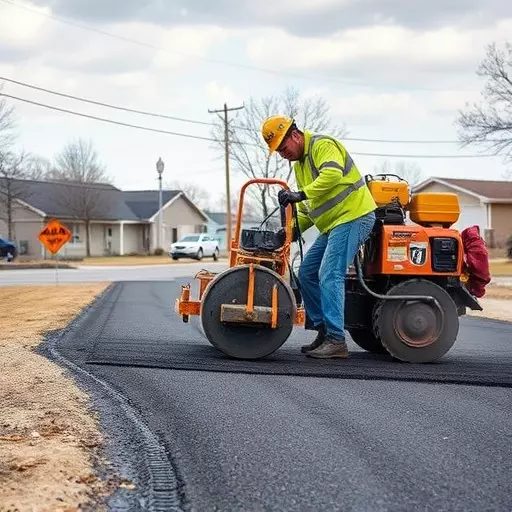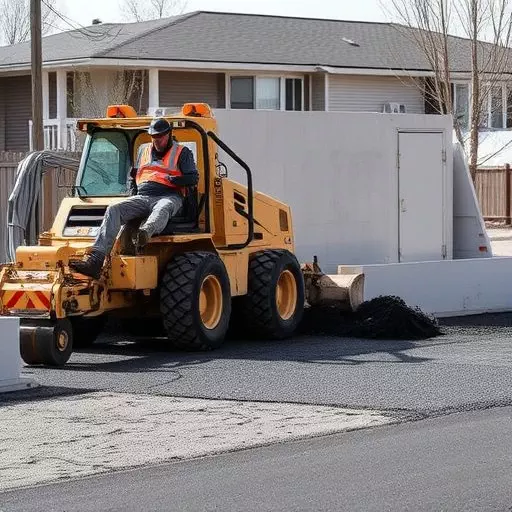Asfalto demolition contractors in Toledo play a crucial role in urban infrastructure maintenance by efficiently removing damaged or cracked asphalt surfaces using specialized techniques like pavement milling. This process saves time and money, protects the environment, and prolongs paved surface lifespans. Various removal methods, including cold milling and hydro-excavation, cater to project needs, budget constraints, and environmental factors. Effective project management by skilled contractors ensures minimal disruption, optimal results, and eco-friendly waste reduction.
The seamless flow of traffic and safety of public spaces heavily rely on well-maintained asphalt surfaces. However, cracks and damages can compromise these essential elements. This article explores the crucial aspect of asphalt demolition, particularly in Toledo, where a professional contractor plays a vital role. We delve into the necessity of controlled demolition for safe and efficient pavement management. Additionally, we uncover common removal methods, including pavement milling, and provide insights on project management strategies to minimize disruptions and maximize results.
- Understanding Asphalt Demolition: Why It's Necessary for Safe and Efficient Pavement Management
- The Role of a Professional Asphalt Demolition Contractor in Toledo: Expertise in Asphalt Removal Techniques
- Common Asphalt Removal Methods: A Comprehensive Overview of Pavement Milling and Alternative Strategies
- Effective Asphalt Demolition Project Management: Ensuring Minimal Disruption and Optimal Results
Understanding Asphalt Demolition: Why It's Necessary for Safe and Efficient Pavement Management
The process of asphalt demolition is a critical component of pavement management, ensuring safety and efficiency in infrastructure maintenance. It involves the strategic removal of damaged or cracked asphalt surfaces to prevent further deterioration and create a foundation for repairs or replacements. As an essential practice, it addresses issues like cracks, potholes, and uneven surfaces that can compromise the integrity of roads, parking lots, and other paved areas.
In Toledo and beyond, hiring a professional asphalt demolition contractor is key. They employ various techniques, including pavement milling, to thoroughly remove the affected layer without disrupting surrounding areas. This method not only saves time and money but also ensures the environment is protected from potential hazards associated with traditional demolition methods. Efficient asphalt removal allows for cost-effective rehabilitation, extending the lifespan of paved surfaces and contributing to a smoother, safer driving experience.
The Role of a Professional Asphalt Demolition Contractor in Toledo: Expertise in Asphalt Removal Techniques
In Toledo, the role of a professional asphalt demolition contractor is indispensable when it comes to revitalizing urban spaces. These experts are equipped with a deep understanding and proficiency in various asphalt removal techniques, ensuring efficient and effective pavement milling processes. By employing specialized equipment and adhering to industry best practices, they safely and meticulously dismantle cracked or damaged asphalt surfaces.
A skilled asphalt demolition contractor Toledo relies on is adept at navigating complex projects, from assessing the condition of existing pavements to implementing tailored removal strategies. They possess the knowledge to select the most suitable method—be it cold milling, hot asphalt removal, or other advanced techniques—based on factors like surface age, severity of damage, and project scope. This expertise guarantees a seamless transition from demolition to reconstruction, ensuring the new pavement’s longevity and structural integrity.
Common Asphalt Removal Methods: A Comprehensive Overview of Pavement Milling and Alternative Strategies
The process of removing cracked or damaged asphalt surfaces is a crucial step in maintaining and improving urban infrastructure. There are several methods employed by an asphalt demolition contractor in Toledo to address this issue, with each technique offering unique advantages depending on the project’s scope and specific needs. One of the most common and efficient asphalt removal techniques is Pavement Milling. This method involves using specialized machinery to grind up the existing asphalt surface, allowing for easy collection and disposal while preparing a clean base for new material.
Beyond traditional pavement milling, alternative strategies have emerged to cater to diverse requirements. For smaller-scale projects or areas with tight access, hand-held grinders or cold cutting tools can precisely cut and remove sections of asphalt. These methods are quieter and more environmentally friendly but may be slower. In contrast, for larger-scale demolitions, hydro-excavation uses powerful water jets to break up the asphalt, followed by vacuum trucks to collect the debris, ensuring efficient removal without damaging underlying structures. Each technique offers a tailored solution, and an asphalt demolition contractor in Toledo can select the most suitable approach based on project specifications, budget, and environmental considerations.
Effective Asphalt Demolition Project Management: Ensuring Minimal Disruption and Optimal Results
Effective Asphalt Demolition Project Management plays a pivotal role in ensuring minimal disruption and optimal results for any asphalt demolition project. A skilled and reputable asphalt demolition contractor Toledo leverages advanced asphalt removal techniques, such as pavement milling, to efficiently break down cracked or damaged surfaces while preserving the underlying base material for reuse. This eco-friendly approach not only reduces waste but also minimizes site disturbance, making it ideal for urban settings.
Proper project management involves meticulous planning, coordination, and adherence to safety protocols. By assessing the scope of work, engaging with stakeholders, and employing appropriate asphalt removal techniques, contractors can ensure the project stays on schedule, within budget, and causes minimal disruption to surrounding areas. This includes coordinating with local authorities, traffic management strategies, and ensuring the safe removal and disposal of asphalt materials.


